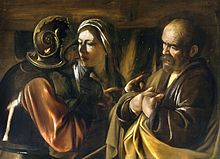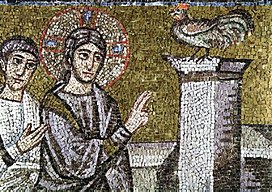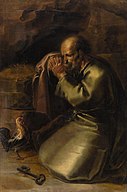Never Tell Me How to Type Again Peter

The Denial of Peter (or Peter's Deprival) refers to iii acts of denial of Jesus by the Campaigner Peter as described in all four Gospels of the New Attestation.[ii]
All four Canonical Gospels land that during Jesus' Terminal Supper with his disciples, he predicted that Peter would deny knowledge of him, stating that Peter would disown him before the rooster crowed the next morning. Post-obit the arrest of Jesus, Peter denied knowing him three times, merely after the tertiary deprival, he heard the rooster crow and recalled the prediction as Jesus turned to look at him. Peter then began to weep bitterly.[3] [a] This terminal incident is known as the Repentance of Peter.[4]
The turbulent emotions behind Peter'due south denial and later repentance have been the subject field of major works of art for centuries. Examples include Caravaggio's Denial of Saint Peter, which is at present at the Metropolitan Museum of Art. The incidents have also inspired segments in various films related to the life and death of Jesus Christ (for instance, when Francesco De Vito performed as Peter in The Passion of the Christ) as well as references in musical works, both religious and secular.
Biblical accounts [edit]



The prediction, made past Jesus during the Last Supper that Peter would deny and disown him, appears in the Gospel of Matthew 26:33–35, the Gospel of Mark 14:29–31, the Gospel of Luke 22:33–34 and the Gospel of John 18:fifteen–27. The denial accounts in the Gospels differ from each other.
According to the Gospel of Matthew:
Peter replied, "Fifty-fifty if all autumn away on business relationship of yous, I never volition." "I tell you the truth," Jesus answered, "This very night, earlier the rooster crows, you volition disown me 3 times." Just Peter declared, "Even if I accept to die with you, I volition never disown you." And all the other disciples said the same.[Matthew 26:33–35]
Later that night, Jesus was arrested. The kickoff deprival to a servant girl in Luke 22:54–57 is every bit follows:
Then they seized him and led him away, bringing him into the high priest's house. Peter followed at a altitude and when they had kindled a burn in the eye of the courtyard and had sat down together, Peter sat down with them. A retainer girl saw him seated at that place in the firelight. She looked closely at him and said, "This man was with him." Just he denied it. "Woman, I don't know him," he said.[Luke 22:55–57]
The second denial to the same daughter in Mark 14:69–lxx is:
When the servant girl saw him there, she said again to those standing around, "This fellow is one of them." Again he denied it.
The third deprival to a number of people, is emphatic equally he curses according to Matthew 26:73–75:
After a little while, those standing at that place went upward to Peter and said, "Surely you are one of them, for your accent gives you abroad." Then he began to telephone call down curses on himself and he swore to them, "I don't know the man!" Immediately a rooster crowed. Then Peter remembered the word Jesus had spoken: "Before the rooster crows, you will disown me iii times." And he went outside and wept bitterly.
The Gospel of Luke 22:59–62 describes the moment of the last denial every bit follows:
About an hour afterward another asserted, "Certainly this young man was with him, for he is a Galilean." Peter replied, "Human being, I don't know what you're talking about!" Simply every bit he was speaking, the rooster crowed. The Lord turned and looked straight at Peter. And so Peter remembered the give-and-take the Lord had spoken to him: "Before the rooster crows today, you will disown me three times." And he went outside and wept bitterly.
The Gospel of John eighteen:13–27 describes the account of the 3 denials as follows:
Simon Peter and some other disciple were post-obit Jesus. Because this disciple was known to the high priest, he went with Jesus into the loftier priest's courtyard, but Peter had to wait exterior at the door. The other disciple, who was known to the high priest, came back, spoke to the girl on duty in that location and brought Peter in. "Y'all are non i of his disciples, are you?" the girl at the door asked Peter. He replied, "I am non." … Every bit Simon Peter stood warming himself, he was asked, "Yous are non one of his disciples, are yous?" He denied it, saying, "I am not." 1 of the high priest's servants, a relative of the homo whose ear Peter had cut off, challenged him, "Didn't I run into you with him in the olive grove?" Again Peter denied it, and at that moment a rooster began to crow.
Following the resurrection of Jesus, the Gospel of John 21:15–17 narrates how Jesus asked Peter three times if Peter loved him, pointing to the rehabilitation of Peter following his repentance.[five]
Context and traditions [edit]

Context [edit]
For much of the catamenia of three years that Jesus spent in ministry, gathering and teaching disciples, he had been observed, criticised and harassed by scholars and priests. His teachings were sometimes seen as heretical and his actions in gathering a group of disciples as perchance having political motivation. Jesus' capture and trials were the culmination of this antipathy.
Peter was one of the twelve disciples almost closely associated with Jesus. His denials are made in the face of allegation that he was "with Jesus", the term indicating the bond of discipleship. The Gospel of Matthew states that Peter denied Jesus "in front of everyone", thus making a public witness, affirming this with an oath.[Matthew 26:72] Throughout his Gospel, Matthew stresses the importance of public witness as an essential element of discipleship, stating in Matthew 10:32–33: "Whoever acknowledges me before men, I will as well admit him before my Male parent in sky. But whoever disowns me before men, I will disown him before my Father in heaven." Peter's denial is in direct disharmonize with the nature of discipleship, as described by Matthew.[six] Matthew has also previously reported Jesus' teaching forbidding the apply of an oath:
"Over again you have heard that it was said to those of former, 'Y'all shall non swear falsely, but shall perform your oaths to the Lord'. But I say to you, do not swear at all: neither by heaven, for it is God'due south throne; nor past the globe, for it is His footstool; nor by Jerusalem, for it is the city of the dandy Male monarch. Nor shall you swear by your head, because you lot cannot make one hair white or black. But allow your 'Aye' be 'Yes,' and your 'No,' 'No.' For whatsoever is more these is from the evil one.[Matthew 5:33–37]
The New Attestation descriptions of Peter'south denial draw the drama of the incident. Peter's antagonists in the give-and-take of his discipleship progress from a maid, to a maid plus a bystander, to a whole crowd. His denial progresses from a plea of ignorance, to a denial plus an oath and then to cursing and swearing with a total deprival that he always knew Jesus. The significance of 3 denials lies in its superlative force; information technology underscores the disciple'southward resolve to deny Jesus (see Biblical numerology). The sound of the rooster then brings a shock to Peter that Jesus had predicted the 3 denials.[vii]
This episode has been seen as an incident that sheds low-cal on the unique function of Peter and sets him apart from the other disciples, just as in the Gospel of Mark sixteen:vii in which the affections tells the women to "get and tell his disciples and Peter" about the resurrection of Jesus.[8] In this episode, as oft elsewhere in the Gospel of Mark, Peter acts equally the focus of the apostles, and an essential Christological paradigm is presented: the denials of Peter contrast with the frank confessions of Jesus in his trial by the Sanhedrin, portraying his faithfulness as prophet, Son and Messiah.[9]
The triple denial of Peter is the impetus for the three repetitive questions made by Jesus to Peter at the Ocean of Galilee later His resurrection, "Simon, son of John, Do you love me?" Although originally interpreted by Peter every bit a rebuke for his 3 denials (also due to the use by Jesus of his old proper name "Simon"), this consequence became later viewed as a redemptive deed past Jesus, allowing Peter to publicly declare in front of his young man disciples that he truly did dearest his Lord and thus become fully restored to his faith community.[John 21:fifteen–17]
The three 'denials' are also nowadays in a Gnostic source, the Apocalypse of Peter from the Nag Hammadi library, but the roles are reversed in the context of meditation and seeing inner vision of the Primary. In the Gnostic Apocalypse of Peter, Jesus denies Peter "three times in this evening" equally not ready for inner sight, 72,5. Both details of "three times" denied and "in this evening" being present suggests a relationship to the approved portrayal of the Denial of Peter.[x]
Prayers and traditions [edit]
Bishop Lancelot Andrewes equanimous the following prayer:
O Lord Jesus Christ, look upon united states with those eyes of thine where-with grand dist look upon Peter in the hall; that with Peter we may repent and, by the same love exist forgiven; for thine endless mercy'southward sake. Amen.
—Aitken 2006, p. 58
Referring to the tears shed by Peter during his repentance in the context of the Sacrament of Penance, Saint Ambrose said that "in the Church, there are water and tears: the water of Baptism and the tears of repentance".[11] Traditionally, "tears of repentance", as exemplified past Peter, accept get a symbol both of mourning and condolement and a sign at once of sins repented and forgiveness sought.[12]
In the Scriptural Way of the Cross, introduced in 1991 by Pope John Paul Two as a version of the Stations of the Cross and performed each Good Friday at the Colosseum in Rome, the quaternary station is the Denial of Peter.[13]
During Holy Week in Jerusalem, vigils at times stop at a location traditionally considered the location for the Repentance of Peter, non far from the house of the High Priest of State of israel Caiaphas, involved in the Sanhedrin trial of Jesus.[fourteen]
In art and music [edit]

The episode has been the bailiwick of works of art for centuries. It has also been dramatized in musical settings of the Passion story. It has been depicted in a varieties of mediums and methods, ranging from sixth century mosaic at the Basilica of Sant'Apollinare Nuovo to Russian icons and oil paintings past many onetime masters. The subject was sometimes included in cycles of the Life of Christ or the Passion, ofttimes as the simply scene non to include the figure of Christ.
In Rembrandt's 1660 depiction of The Deprival of Saint Peter, now in the Rijksmuseum, Amsterdam, influenced past engravings of the c.1623 version by Gerard Seghers, he presents the retainer daughter who recognizes Peter with a candle, illuminating Peter's confront. Two soldiers wait with suspicion as Peter speaks, while Jesus is shown in the distance, his hands leap backside him, turning to wait at Peter. Peter's faces away from Jesus, and he gestures with his left hand, although his expression is gratis of defiance.[fifteen]
Caravaggio's 1610 Denial of Saint Peter is now at the Metropolitan Museum of Art in New York. Author George Weatherhead admires Caravaggio's delineation, the way Peter exhibits a wavering trepidation in his unsteady features, witting of the unworthy falsehood he was telling. His lips quiver and his eyes seek, yet can not find the compactness of truth.[sixteen] In this painting, Caravaggio portrayed the servant girl using the aforementioned head of the woman that he used in his depiction of The Beheading of Saint John the Baptist.[17]
A related subject, the Repentance of Peter, showing the cease of the episode, was not often seen before Catholic Counter-Reformation art, where it became popular every bit an assertion of the sacrament of Confession against Protestant attacks. This followed an influential book by the Jesuit Primal Robert Bellarmine (1542–1621). The epitome typically shows Peter in tears, as a half-length portrait with no other figures, often with hands clasped every bit at correct, and sometimes the cock in the background; information technology was often coupled with a repentant Mary Magdalen, another exemplar from Bellarmine's book.[xviii]
The Passion story has been gear up in music by numerous composers. The episode of Peter'south deprival is conveyed with great poignancy by J.S. Bach in both the St Matthew Passion and the St John Passion. Gardiner 2013, p. 365 says "Inevitably nosotros endure with Peter; just the uncomfortable question Bach asks us to consider is, would any of us have emerged from his ordeal with greater credit?.
- Denial of Saint Peter in art
-

-

-
-

-

-

January van der Venne : Deprival of Saint Peter
-

Knüpfer, Denial of Saint Peter
-

Gerard van Honthorst, The Denial of Saint Peter, c. 1618–20
See also [edit]
- Confession of Peter
- Doubting Thomas
- Gospel harmony
- Jesus predicts his expiry
- Life of Jesus in the New Testament
References [edit]
Notes [edit]
- ^ In the Gospel of John, Peter does not react to the rooster'south exultation; unlike the Synoptics, he is not said to retrieve Jesus' prediction nor to express regret about his denials.
Citations [edit]
- ^ "The Denial of St. Peter". N Carolina Museum of Art. Retrieved 15 April 2019.
- ^ Cullmann 1969, p. 105.
- ^ Perkins 2000, p. 85.
- ^ Lange 1865, p. 499.
- ^ Boda & Smith 2006, p. 110.
- ^ Binz 1989, p. 54.
- ^ Herrington 1992, p. 900.
- ^ Perkins 2000, p. 65.
- ^ Broadhead 1994, p. 154.
- ^ "The Apocalypse of Peter". The Nag Hammadi Library. Gnosis. Retrieved 2018-04-19 .
- ^ "Catechism of the Cosmic Church". Vatican. 1429. Retrieved 2018-04-19 .
- ^ Boda & Smith 2006, p. 223.
- ^ "Station 4, Jesus is denied by Peter". Stations of the Cross. Vatican. Retrieved 2018-04-nineteen .
- ^ Monti 1993, p. 150.
- ^ Durham 2004, p. 162.
- ^ Weatherhead 1834, p. 232.
- ^ Varriano 2006, p. 110.
- ^ Hall 1983, pp. 10, 315.
Sources [edit]
- Aitken, Jonathan (2006), Prayers for People Under Pressure, Bloomsbury Academic, ISBN978-0-8264-8275-4
- Binz, Stephen J. (1989), The Passion and Resurrection Narratives of Jesus: A Commentary, Liturgical Press, ISBN978-0-8146-1771-7
- Boda, Marker J.; Smith, Gordon T. (2006), Repentance in Christian Theology, Liturgical Press, ISBN978-0-8146-5175-9
- Broadhead, Edwin Keith (1994), Prophet, Son, Messiah: Narrative Grade and Part in Marker 14-16, A&C Black, ISBN978-one-85075-476-3
- Cullmann, O. (1969), Gerhard Kittel; Gerhard Friedrich (eds.), Theological Dictionary of the New Testament, vol. VI, translated by Bromiley, Geoffrey William, Wm. B. Eerdmans, ISBN978-0-8028-2248-ii
- Durham, John I. (2004), The Biblical Rembrandt: Man Painter in a Landscape of Organized religion, Mercer University Printing, ISBN978-0-86554-886-2
- Gardiner, John Eliot (2013), Music in the Castle of Heaven: A Portrait of Johann Sebastian Bach, Penguin, ISBN978-1-84614-721-0
- Hall, James (1983), A History of Ideas and Images in Italian Art, Harper & Row, ISBN978-0-06-433317-7
- Herrington, Daniel J. (1992), Karris, Robert J. (ed.), The Collegeville Bible Commentary, vol. New Testament, NAB, Liturgical Press, ISBN978-0-8146-2211-vii
- Lange, Johann Peter (1865), The Gospel According to Matthew, New York: C. Scribner
- Monti, James (1993), The week of conservancy: history and traditions of Holy Week, Our Sunday Company, ISBN978-0-87973532-6
- Perkins, Pheme (2000). Peter: Apostle For The Whole Church. Bloomsbury. ISBN978-0-567-08743-0.
- Varriano, John L. (2006), Caravaggio: The Art of Realism, Pennsylvania State University Press, ISBN978-0-271-02717-three
- Weatherhead, George Hume (1834), A Pedestrian Bout Through France and Italy, Simpkin & Marshall
- Witherington, Ben (1998), The Acts of the Apostles, Wm. B. Eerdmans, ISBN978-0-8028-4501-6
Further Reading [edit]
- Knecht, Friedrich Justus (1910). . A Practical Commentary on Holy Scripture. B. Herder.
Source: https://en.wikipedia.org/wiki/Denial_of_Peter

0 Response to "Never Tell Me How to Type Again Peter"
Post a Comment